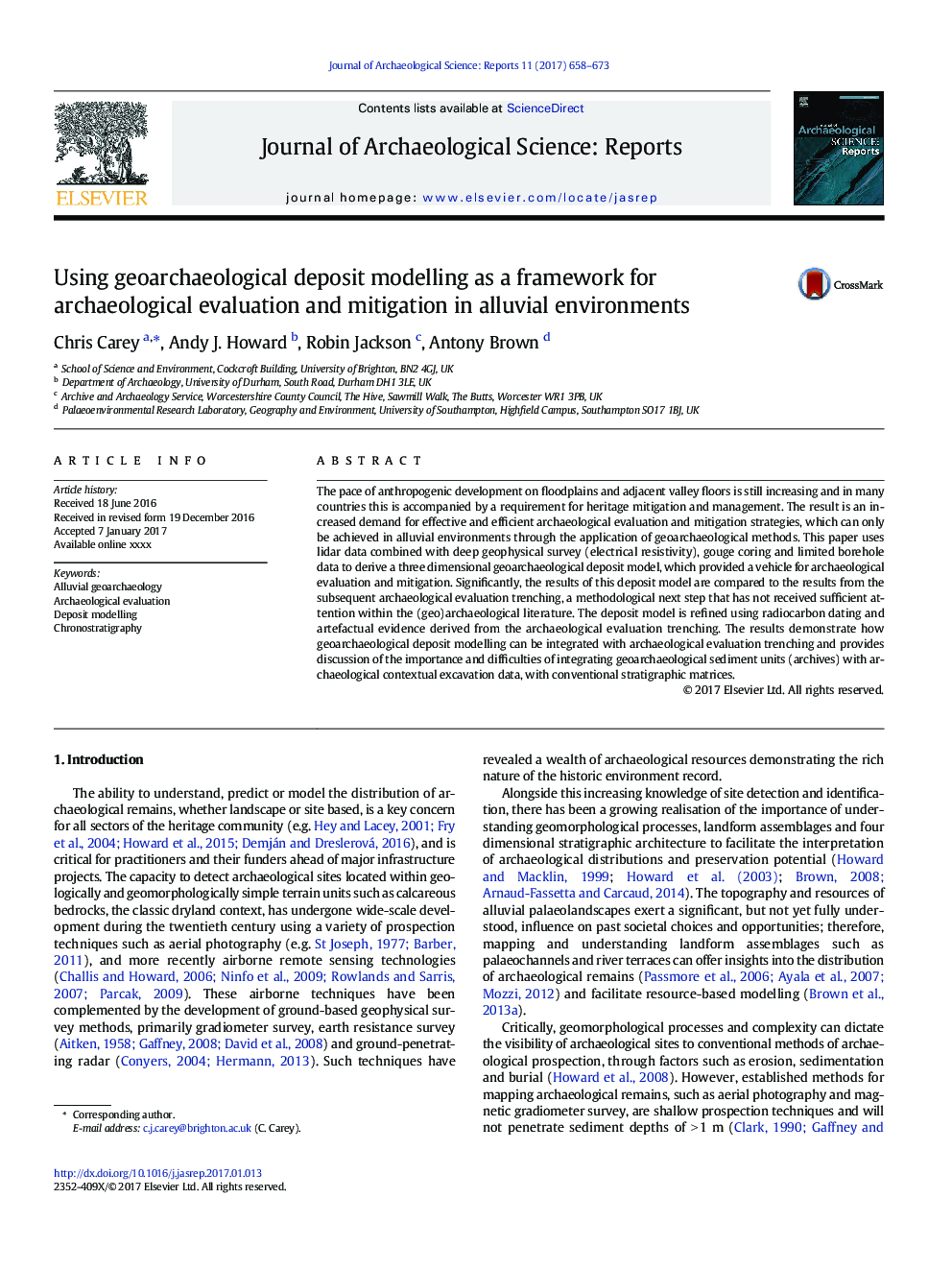| کد مقاله | کد نشریه | سال انتشار | مقاله انگلیسی | نسخه تمام متن |
|---|---|---|---|---|
| 5112594 | 1483932 | 2017 | 16 صفحه PDF | دانلود رایگان |
عنوان انگلیسی مقاله ISI
Using geoarchaeological deposit modelling as a framework for archaeological evaluation and mitigation in alluvial environments
ترجمه فارسی عنوان
با استفاده از مدل سازی سپرده های ژئواسترامی شناسی به عنوان چارچوبی برای ارزیابی و کاهش باستان شناسی در محیط های آبرفتی
دانلود مقاله + سفارش ترجمه
دانلود مقاله ISI انگلیسی
رایگان برای ایرانیان
کلمات کلیدی
ترجمه چکیده
سرعت توسعه انسانی در سیلاب ها و دره های مجاور دره هنوز هم افزایش می یابد و در بسیاری از کشورها این نیاز به کاهش و مدیریت میراث است. نتیجه تقاضای افزایش یافته برای ارزیابی و بهینه سازی باستان شناسی موثر و کارآمد است که می تواند تنها با استفاده از روش های ژئوروآموزشی در محیط های آبرفتی حاصل شود. این مقاله با استفاده از داده های لیدار همراه با بررسی ژئوفیزیک عمیق (مقاومت الکتریکی)، داده های برآمدگی و داده های گمانه محدود به منظور استخراج مدل سه بعدی ژئوروشنا شناسی جغرافیایی، که وسیله ای برای ارزیابی و کاهش باستان شناسی است، استفاده می کند. به طور قابل توجهی، نتایج این مدل سپرده با نتایج حاصل از ارزیابی تربیت باستان شناسی مقایسه می شود، گام بعدی روش شناختی که در ادبیات (جغرافیایی) باستان شناسی مورد توجه کافی قرار نگرفته است. مدل سپرده با استفاده از قدم زدن رادیو کربن و شواهد مصنوعی حاصل از ارزیابی باستان شناسی، پردازش می شود. نتایج نشان می دهد که چگونه مدل سازی سپرده های ژئوشیمیایی را می توان با اره ارزیابی باستان شناسی یکپارچه کرد و بحث در مورد اهمیت و مشکلات ادغام واحدهای رسوبی جغرافیائی (بایگانی ها) با داده های کاوش های باستان شناختی با ماتریس های سلسله مراتبی معمول را ارائه می دهد.
موضوعات مرتبط
علوم انسانی و اجتماعی
علوم انسانی و هنر
تاریخ
چکیده انگلیسی
The pace of anthropogenic development on floodplains and adjacent valley floors is still increasing and in many countries this is accompanied by a requirement for heritage mitigation and management. The result is an increased demand for effective and efficient archaeological evaluation and mitigation strategies, which can only be achieved in alluvial environments through the application of geoarchaeological methods. This paper uses lidar data combined with deep geophysical survey (electrical resistivity), gouge coring and limited borehole data to derive a three dimensional geoarchaeological deposit model, which provided a vehicle for archaeological evaluation and mitigation. Significantly, the results of this deposit model are compared to the results from the subsequent archaeological evaluation trenching, a methodological next step that has not received sufficient attention within the (geo)archaeological literature. The deposit model is refined using radiocarbon dating and artefactual evidence derived from the archaeological evaluation trenching. The results demonstrate how geoarchaeological deposit modelling can be integrated with archaeological evaluation trenching and provides discussion of the importance and difficulties of integrating geoarchaeological sediment units (archives) with archaeological contextual excavation data, with conventional stratigraphic matrices.
ناشر
Database: Elsevier - ScienceDirect (ساینس دایرکت)
Journal: Journal of Archaeological Science: Reports - Volume 11, February 2017, Pages 658-673
Journal: Journal of Archaeological Science: Reports - Volume 11, February 2017, Pages 658-673
نویسندگان
Chris Carey, Andy J. Howard, Robin Jackson, Antony Brown,
